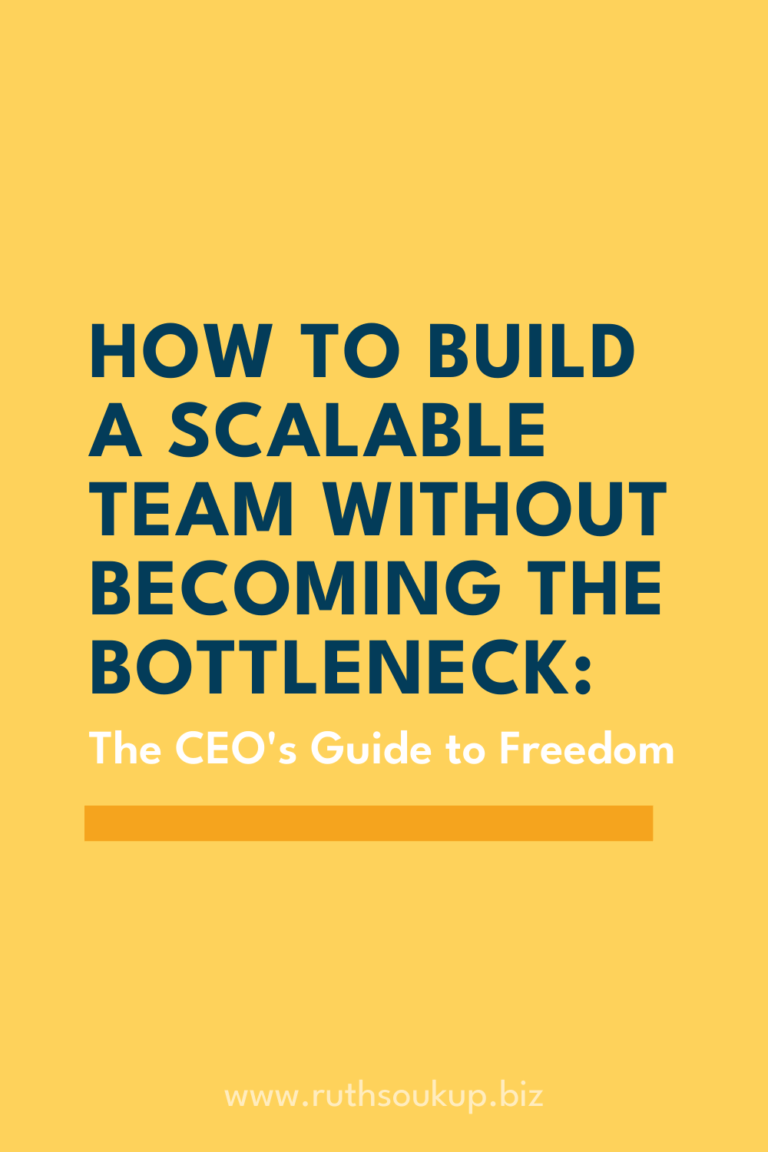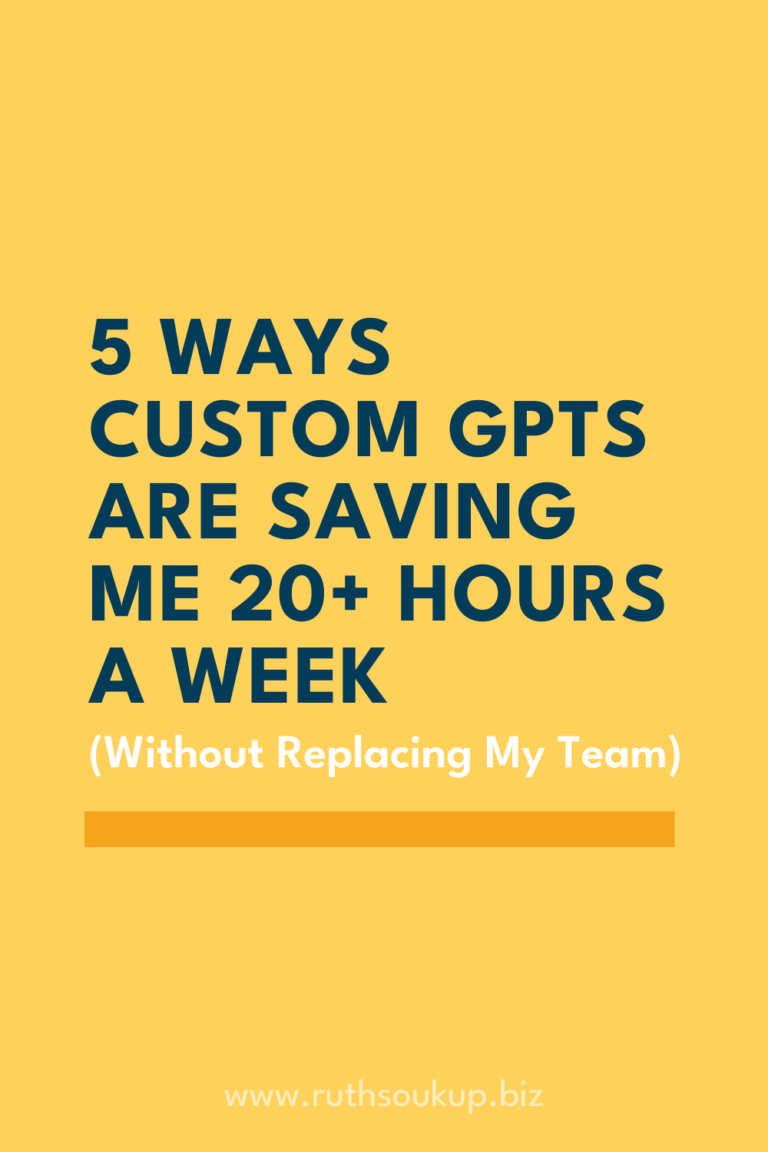How to Make Every Hour Count (When You’re the Bottleneck in Your Business): A CEO’s Guide

The Pain: You’re Drowning in Tasks That Shouldn’t Be Yours
Let me guess.
You didn’t start your business to spend your days drowning in a sea of Slack pings, email backlogs, broken links, launch prep, and “quick questions” from your VA that somehow take 45 minutes to answer.
And yet… here you are.

It’s Time to Take Your Seat at the Big Table
Let’s be honest—there’s a difference between having a business… and being in the room where real growth happens.
Powerhouse is our private coaching experience for online entrepreneurs who are ready to scale past six figures—and step fully into their next-level leadership.
It’s the big kid’s table. The one where strategy matters more than hustle, and every conversation moves you forward.
If you know you’re meant for more, this is your invitation to join us.
You’ve got a growing business, a calendar that looks like a game of Tetris, and a never-ending to-do list that makes you wonder if you are the problem.
(Spoiler: You are. But not in the way you think.)
Because the truth is this:
You can’t scale what you won’t let go of.
And if you’re still trying to personally touch every piece of your business—approving every email, rewriting every caption, jumping into every client issue, running every meeting—you’re not leading. You’re clogging the pipeline.
This post is your wake-up call.
If you’re serious about hitting 7 figures without burning out, it’s time to stop managing time—and start managing your role.
Let’s talk about what that actually looks like.
From Bottleneck to $5M Ecosystem
I’ll be honest.
This one hits close to home.
There was a time when I thought “making every hour count” meant squeezing the life out of every minute. Waking up at 3 AM. Scheduling my day in 15-minute increments. Multitasking like it was my superpower.
But all that hustle? It only got me so far.
At $500K/year, my business was growing—but I was exhausted. My team was confused. And I couldn’t take a single day off without everything grinding to a halt.
Why? Because I was still at the center of everything.
The emails. The approvals. The launch plans. The decisions. All of it flowed through me—creating a massive bottleneck that was strangling my business’s potential.
That was the year I realized I needed to create something different.
So I did the uncomfortable thing. I restructured. Delegated. Systematized. Built SOPs. Created an ecosystem that could run without me checking every single box.
And guess what?
That’s when everything changed.
We scaled to $5M+ not because I worked harder—but because I stopped being the bottleneck.
You Don’t Need More Hours—You Need Better Systems
Here’s the mindset shift that changed everything for me:
Your job isn’t to do more.
Your job is to build a business that runs without you doing it all.
The entrepreneurs who scale sustainably aren’t the ones working 80-hour weeks.
They’re the ones who’ve built systems, boundaries, and workflows that create freedom—not just more to manage.
Here are five core shifts that help you reclaim your time and step fully into your CEO role:
1. Redefine Your CEO Role
You are not your own tech support.
Or copy editor.
Or customer service rep.
You are the visionary, the strategist, and the decision-maker.
Start acting like it.
Ask yourself:
What are the 2–3 highest-value activities only I can do?
For me, that’s:
- Content strategy
- Offer creation
- High-level coaching
Everything else? It’s either delegated or eliminated.
Still not sure what’s worth your time?
Look at what directly drives revenue or requires your unique expertise.
If someone else could do it 80% as well—it shouldn’t be on your plate.
2. Audit Your Time (Even If It’s Painful)
Track your time for one week. Seriously.
Then categorize it like this:
- $10/hour tasks: Admin, email replies, formatting docs, uploading content
- $100/hour tasks: Creating content, managing your team, improving client experience
- $1,000/hour tasks: Crafting offers, sales strategy, launch planning, long-term visioning
If your calendar is packed with $10/hour tasks but your revenue goal is $500K or $1M… something’s off.
Your time should reflect your vision.
3. Design a Weekly CEO Schedule
You need recurring time for:
- Deep work (2–3 hours of uninterrupted focus)
- CEO time (90 minutes weekly for strategic thinking)
- Team syncs (only when needed—not just because it’s Tuesday)
Protect your energy like your business depends on it. Because it does.
My personal non-negotiable? No meetings before 11am.
That’s when I do my best creative work, and I guard it fiercely.
That single boundary has created more momentum than any productivity hack ever could.
4. Systematize What’s Repeating
If you’ve done it more than once, it needs a system.
Every repeatable task should have a checklist, a Loom video, or a short SOP.
It doesn’t have to be fancy—it just needs to be clear.
If your VA keeps asking how to upload a podcast episode, that’s not on them.
That’s on your system.
One of the most powerful shifts we made was creating a “Content Approval Workflow.”
Now my team can self-review almost everything against our brand standards—and I only review about 20% of what goes out.
That’s what freedom looks like.
5. Empower Your Team to Lead (Not Just Execute)
If you’re stuck rewriting everything your team does, that’s not leadership—it’s micromanagement.
Define the outcome, not just the task.
Give clear ownership.
Coach your team to grow, rather than holding onto control out of fear.
Because here’s the truth:
You don’t need more hours.
You need better delegation.
You need real systems.
And you need to stop being the bottleneck.
5 Critical Mistakes to Avoid When Scaling Your CEO Role
Even the smartest entrepreneurs fall into these traps. Here are the most common bottlenecks I see with my Powerhouse clients—and how to avoid them:
1. The “I’ll Just Do It Myself” Syndrome
You think: “It’ll take me 10 minutes to fix this myself versus 30 minutes to explain it to someone else.”
The reality: Those 10-minute tasks add up to hours of work that keeps you stuck in the weeds.
The fix: Track how many times you say “I’ll just do it myself” in a week. Each instance is a system waiting to be built.
2. Mistaking Activity for Progress
You think: Being busy equals being productive.
The reality: Checking 30 small tasks off your list feels good but doesn’t move the needle on growth.
The fix: At the end of each day, ask yourself: “Did I complete at least one high-leverage activity that directly impacts my revenue or scalability?”
3. Over-Engineering Your Systems
You think: “We need fancy software and complex workflows for everything.”
The reality: Over-engineered systems often create more work and rarely get followed.
The fix: Start with simple checklists. Perfect is the enemy of done—and simple systems actually get used.
4. The “Always Available” Trap
You think: Being responsive shows you care about your team and clients.
The reality: Constant availability trains everyone to depend on you for every decision.
The fix: Set specific office hours for team questions and stick to them religiously. Your team will adapt faster than you think.
5. Perfection Paralysis
You think: “If I want it done right, I need to review everything.”
The reality: Your need for perfection is holding your entire business hostage.
The fix: Define “good enough” for different types of deliverables. Some things need to be perfect; most just need to be complete.
Belief Shift: You’re Not Lazy—You’re Over-Involved
So let’s reframe this once and for all:
If you’re stuck in the weeds, it doesn’t mean you’re not productive.
It means your business model is broken.
It means your time is serving the wrong priorities.
And it means the path to more growth doesn’t start with a new planner or a time-blocking app—it starts with stepping into your real role as CEO.
Because this isn’t about time management.
It’s about leadership.
And if you want your business to run (and scale) without you…
You have to build it that way—on purpose.
FAQ: How to Stop Being the Bottleneck and Step Into Your Real CEO Role
How do I know if I’m the bottleneck in my business?
If every task, decision, or piece of content flows through you—you’re the bottleneck.
Signs include:
- Rewriting your team’s work
- Approving every email, caption, or graphic
- Being the default “problem solver” for everything
- Feeling like you can’t step away without chaos
The fix isn’t more time—it’s better systems and smarter delegation.
What should I stop doing to scale beyond $250K–$500K?
You should stop:
- Answering every email or Slack ping yourself
- Running every meeting “just to stay in the loop”
- Approving content that already follows your brand standards
- Doing $10/hour tasks when you’re aiming for $1M+
Start asking: What’s the highest-value work only I can do?
Everything else needs to be systematized or delegated.
How do I decide what to delegate first?
Start by auditing your time for one week. Categorize tasks by value:
- $10/hour tasks: Admin, inbox, formatting, uploading content
- $100/hour tasks: Content creation, client delivery, team leadership
- $1,000/hour tasks: Offer design, launch strategy, vision work
Anything that doesn’t drive revenue or require your brain? It’s ready to be offloaded.
How do I delegate without losing quality?
Simple: Delegate outcomes, not just tasks.
Tell your team what done looks like, not just what to do.
Also:
- Use Loom to record walkthroughs
- Create checklists or SOPs (they don’t have to be fancy)
- Review less over time—start with 100%, then move to 20%
The more you define, the less you’ll need to “fix.”
What systems help me stop micromanaging?
Start here:
- A weekly CEO schedule with protected deep work time
- A team question doc or Slack thread to reduce random pings
- Standard workflows for content, support, and delivery
- Simple SOPs stored in Google Docs, Notion, or Asana
Your systems are your freedom. Without them, your team will keep pulling you into the weeds.
What’s the biggest mindset shift I need to scale my role?
This: You’re not lazy. You’re over-involved.
Letting go isn’t a weakness—it’s a strategy.
Real CEOs don’t try to do everything. They build machines that scale without them in every cog.
How do I train my team to lead instead of just execute?
- Start with ownership: Assign outcomes, not tasks
- Offer frameworks: Decision trees, guidelines, checklists
- Create boundaries: Set “office hours” for questions
- Celebrate initiative: Praise problem-solving, not perfection
When your team knows what success looks like—and is allowed to own it—they’ll rise.
What are the most common mistakes CEOs make when delegating?
- Saying “I’ll just do it myself” too often
- Waiting until they’re burned out to hire
- Over-engineering systems that no one uses
- Being constantly available
- Confusing perfection with progress
You don’t need more time. You need better systems.
What’s my next move if I want to stop doing it all myself?
🔥 Watch the Firestarter Training
You’ll learn:
- How to identify the real bottlenecks slowing you down
- The system I used to step out of day-to-day operations
- How to build a team and business that runs without you in every role
- Why time management isn’t your problem—leadership is
Ready to Step Into Your CEO Era?
If you’re tired of feeling like the bottleneck in your own business, it’s time for a better plan.
My free Firestarter Training will show you the exact system I used to scale to $5M+ without hustle, burnout, or live launches.
It’s 100% free, and it will walk you through:
- How to design an evergreen sales engine
- The 5 shifts every 6-figure entrepreneur must make
- My blueprint for scaling with simplicity
Click here to watch it now.Let’s build a business that works for you—not because of you.








Wow, awesome posts! I’ve been a full-time blogger for the last decade. However, lately the lines have become blurred as to what a high priority task is anymore as everything seems important these days. I find myself having difficulty prioritizing tasks and staying focused on single tasks, this article helped. Thanks.
This is really good advice and it works. I always feel like I have a million thoughts swirling around in my head. When I write them down and prioritize each task, my to-do list doesn’t feel so overwhelming somehow. Setting a timer also really works for me. Even though I have a set task, it can be easy for my mind to wander and start thinking about what’s next. When I have that timer running, I tend to focus more on the task I’m working on.